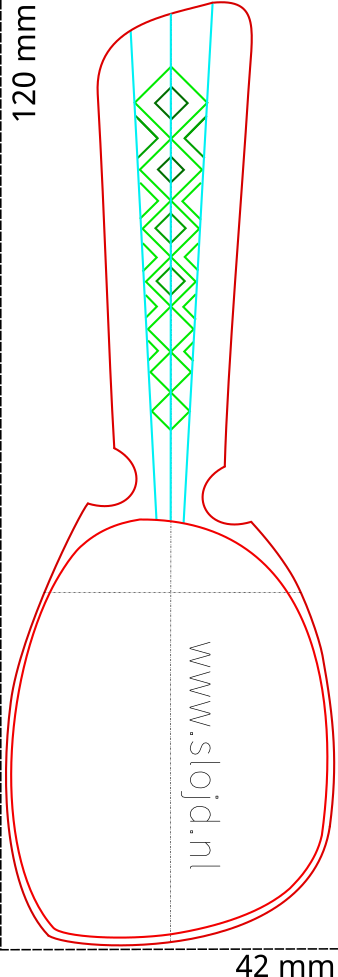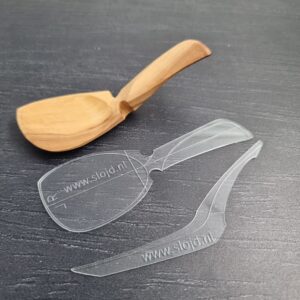At the previous Dutch Spoonfest I was asked to give a workshop about the pocket spoon. That is why I designed the spoon in this blog. Because I also gave a workshop about the carving technique, an idea for the decoration also came about. In this blog you can read more about this pocket spoon and you can also download a free PDF template to make it yourself. Have fun carving and watch out for your fingers!
No ‘new kid on the block’
The ‘Pocket Spoon’ as we spoon carvers know it is the brainchild of JoJo Wood. It is intended as a means of reducing waste. The idea is that having this spoon with you always, will lead to less use of disposable cutlery. At first it was mainly about plastic cutlery (which has now been banned in Europe), but the wooden factory-produced variant is also and remains a disposable item. Jojo made her own website especially for the ‘Pocket Spoon’, on which she also has a template that the spoon carvers among us can use. The concept appealed to many makers and we now know the pocket spoon in many shapes and sizes!
In fact, the idea of the ‘pocket spoon’ is centuries old. Seasonal workers who moved from farm to farm often had only the clothes they wore and a wooden spoon. When they entered service, they hung their spoon in the spoon rack above the dining table. If they wanted to resign, they symbolically took their spoon from the rack to show that they were moving on.
The idea of a compact carry-along spoon is certainly not new. Not even in this day and age of lightweight camping equipment. Although these camping spoons are usually made of plastic, titanium or stainless steel, the wooden spoon is often lighter than its titanium rival.
Carving a pocket spoon
If you want to make a small spoon that also has to be able to take a beating, there are a few things to take into account. When designing this pocket spoon I chose to make it small enough that it actually fits comfortably in your pocket or bag.
Functionality
With such a small spoon, functionality is the challenge. If you really want to continue using the pocket spoon, it must be easy to eat with. The bowl must therefore have sufficient volume and be able to scoop up all kinds of food. Also a soup. With extremely short handles like in this design, you can see that the spoon actually only consists of the crank from the bowl to the handle.
Proportions
The second challenge is the proportions. The smaller the spoon, the faster a design feels of if you just make the proportions smaller. In my experience it works best to adjust the proportions, personally I like the ratio 1:1 (bowl:stem) with shorter handles.
Strength
The third challenge is making a strong spoon. Especially if you make the spoon out of straight wood. In that case what can happen is that the transition from the handle to the bowl becomes too weak due to the grain direction of your wood. To make the shape robust enough, I deliberately leave a deep keel that extends quite a bit into the handle. If you also leave this keel a bit round in shape, the spoon will be extremely strong.
And finally, as always in my workshops, I come back to form follows function. There is therefore a small recess in the handle to give those few fingers a little extra grip on that short handle.
Decorating
A spoon becomes even more personal if you decorate it. At the same Spoon Festival where I first made this spoon with students, I also gave a workshop on the decorating technique (chip carving). On the template you will find a suggestion on how you could approach this. But making your own is more fun!
Free template
Would you like to make this spoon yourself? You can download and print the template here.
Have you got the hang of it and want a more sustainable template? Then the template is also available in the web shop. This also includes the side profile, so you can determine how much crank / curvature you want to make in your spoon. Shipping to the Netherlands, Belgium and Germany is available. For other countries, please contact me.

